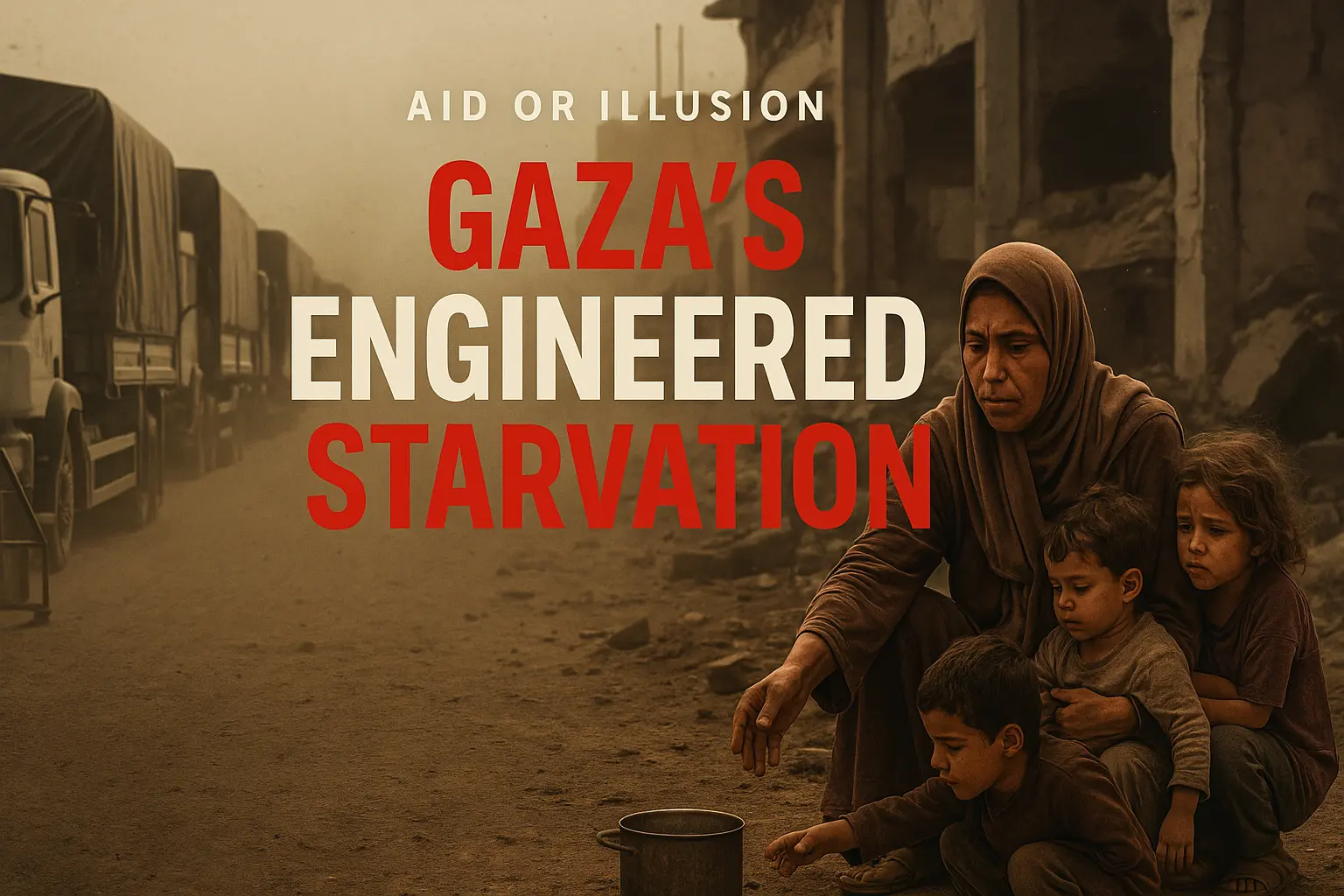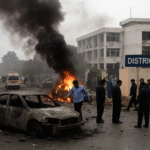Gaza famine, engineered starvation, Gaza aid crisis, Israel blockade, humanitarian crisis in Gaza, famine as weapon, Gaza food ban, UN famine report, Gaza starvation 2025, White House Gaza trucks, aid manipulation, Gaza malnutrition, Palestinian starvation, siege warfare Gaza.
The United States proudly highlights that almost 700 aid trucks enter Gaza each day. Yet within the enclave, hunger deepens, and children die of dehydration. How can a place “flooded with aid” still face famine? Because what’s happening in Gaza isn’t logistics failure it’s calculated deprivation. The statistics may impress journalists in Washington, but for families in northern Gaza, they mean nothing. The truth is stark: Gaza’s starvation is engineered, designed through policy, control, and selective access.
2. The Mirage of Numbers
According to the White House, nearly 674 trucks enter Gaza daily. But Palestinian authorities record only around 170 actually reaching civilians far short of the 600 trucks per day minimum required to feed 2.3 million people.
Most of those trucks, say aid workers, carry commercial goods, not nutrition: crisps, soft drinks, and sweets not bread, milk, or protein. Counting trucks without counting calories is a deliberate deception. It transforms a humanitarian catastrophe into a public relations achievement.
3. Selective Starvation: When Policy Replaces Chaos
True chaos produces random shortages. Gaza’s pattern, however, is strategic selection.
Over 350 essential food items are banned, including meat, eggs, and vegetables. Meanwhile, less nutritious and high-profit items are permitted.
This isn’t coincidence it’s control. Israel’s long-standing “calorie policy,” first exposed by human rights group Gisha in 2012, literally calculated how much food Gaza’s population could survive on about 2,279 calories per person per day. Not to thrive, but to barely subsist.
That same logic survives today: keep Gazans alive enough to avoid genocide charges, yet weak enough to prevent resistance.
4. History of Starvation as a Weapon
Starvation has long served as a silent instrument of state power.
• In World War I, Britain’s blockade on Germany killed over 400,000 civilians.
• During Biafra (1967–70), Nigeria used hunger to crush secession, leading to a million deaths.
• In Yemen, air and sea blockades brought UN-confirmed famine conditions.
In each case, starvation was weaponized hidden behind “security” or “inspection delays.” Gaza’s story fits the same template: control supply lines, deny nutritional goods, and cite “security needs.”
5. The Geography of Denial
UN agencies confirm that southern Gaza receives partial aid, while northern Gaza — where famine is worst — remains nearly cut off. Convoys to the north face repeated denials and attacks.
This is deliberate humanitarian zoning starving one region to force displacement toward another. It transforms geography into leverage: the farther you are from Israeli-controlled crossings, the hungrier you become.
6. The Statistical Illusion
Before the war, Gaza required about 600 trucks daily in peacetime. Today, with twice the need and half the infrastructure, it needs at least 1,000 trucks daily.
Even if 700 trucks enter, the math fails: most don’t reach distribution zones. In truth, Gaza receives less than half the required aid, and much of that lacks protein, vitamins, or medical nutrition. It’s a humanitarian charade aid as optics, not outcome.
7. Human Testimony: Ground Realities in Gaza
On-the-ground evidence exposes the policy’s cruelty more than any number can:
• Mothers mixing animal feed with water to make bread.
• Children eating grass and leaves to suppress hunger.
• Doctors treating babies dying from malnutrition, not bomb wounds.
UNRWA staff confirm that malnutrition and child wasting are at record highs. Gaza is not starving by accident; it’s being kept on the edge of famine by design.
8. The U.S. Role Humanitarian Optics vs Strategic Cover
The White House’s “aid surge” serves two purposes:
1. To soothe domestic conscience in the U.S. showcasing compassion without confronting Israel.
2. To provide political cover for Israel letting it claim compliance with international law.
But UN field data tells another story: more trucks, yet worsening hunger.
If aid were truly working, malnutrition rates would drop. They haven’t. The so-called surge is an illusion — a moral alibi in place of accountability.
9. Starvation as Psychological Warfare
Beyond physical suffering, starvation attacks the mind.
It dismantles community resilience, fuels despair, and forces migration. Each meal becomes a negotiation with survival. This is psychological warfare at its most silent a way to break resistance without bullets.
Colonial empires once used hunger to subdue populations; now, modern democracies use bureaucracy. Gaza’s people are trapped not behind walls of concrete, but walls of paperwork and checkpoints.
10. The UN Verdict
The UN Integrated Food Security Phase Classification (IPC) lists Gaza at Phase 5 Catastrophe, its highest alert level.
• Over 90% of Gazans face “crisis or worse” food insecurity.
• 500,000+ live in famine-like conditions.
• Children under 5 are wasting away at emergency levels.
These are UN-verified facts, not Palestinian claims. They confirm that aid entry does not equal food access. The crisis is not humanitarian in nature; it’s systematic deprivation.
11. Israel’s Long-Term Blockade Doctrine
Since 2007, Israel’s blockade has followed a clear logic: “no prosperity, no collapse.”
This policy ensures Gaza survives but never recovers. Economic permits, import lists, and crossing approvals are used as levers of obedience.
When global outrage spikes, crossings open briefly; when attention fades, restrictions return.
It’s a calibrated system of control — starvation managed like policy, not tragedy.
12. The Moral Geometry
Starvation doesn’t explode — it erodes. It kills quietly, allowing perpetrators to claim legality.
International law explicitly bans “starvation of civilians as a method of warfare.” Yet, enforcement remains toothless because the starvation in Gaza is bureaucratically disguised — framed as “inspection,” “security,” or “logistics.”
This is moral inversion: the act of starving civilians while claiming to save them.
13. The Logical Conclusion
Let’s strip this to pure logic:
1. Aid entry is rising, but hunger is worsening.
2. Nutritious items are banned, while junk food enters freely.
3. Northern Gaza remains cut off despite open crossings in the south.
4. Global pressure changes rhetoric, not policy.
Hence, this is not humanitarian failure — it’s engineered starvation, planned, monitored, and politically sanitized.
14. FAQs on Gaza’s Engineered Starvation
Q1. Why is Gaza still facing famine if 700 aid trucks enter daily?
Because most trucks are commercial, not food-focused. Many never reach civilians, especially in northern Gaza.
Q2. What foods are banned from entering Gaza?
Over 350 basic items, including meat, eggs, cheese, vegetables, and vitamins — essentials for survival.
Q3. Is there proof of deliberate starvation policy?
Yes. Israel’s 2012 “calorie policy” documents exposed the calculation of minimum survival intake. The pattern continues today.
Q4. What does the UN say about Gaza’s food crisis?
The UN categorizes Gaza’s situation as Phase 5 — Catastrophe, confirming widespread famine-like conditions.
Q5. Why do U.S. and Palestinian figures differ?
Washington counts all trucks crossing borders (including commercial shipments). Palestinians and NGOs count actual humanitarian deliveries.
Q6. Is starvation considered a war crime?
Yes. Under Article 54 of the Geneva Convention, starvation of civilians as a method of warfare is explicitly prohibited.
15. Conclusion – The Illusion of Aid
Gaza’s tragedy exposes a brutal irony: aid itself has become a weapon.
Every truck touted by Western officials is a data point in diplomacy, not a meal for a child. What the world calls “relief,” Gazans experience as rationed survival.
This isn’t a humanitarian crisis born of chaos it’s a policy of hunger, executed with precision, justified with numbers, and hidden behind compassion’s mask.
Until that truth is confronted, the famine in Gaza will remain not a failure of logistics but of humanity.










